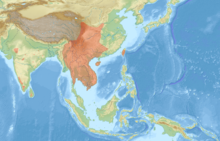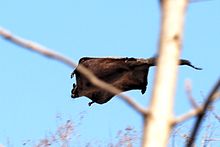
Squirrels are members of the family Sciuridae, a family that includes small or medium-sized rodents. The squirrel family includes tree squirrels, ground squirrels, and flying squirrels. Squirrels are indigenous to the Americas, Eurasia, and Africa, and were introduced by humans to Australia. The earliest known fossilized squirrels date from the Eocene epoch, and among other living rodent families, the squirrels are most closely related to the mountain beaver and to the dormice.

Flying squirrels are a tribe of 50 species of squirrels in the family Sciuridae. Despite their name, they are not in fact capable of full flight in the same way as birds or bats, but they are able to glide from one tree to another with the aid of a patagium, a furred skin membrane that stretches from wrist to ankle. Their long tails also provide stability as they glide. Anatomically they are very similar to other squirrels with a number of adaptations to suit their lifestyle; their limb bones are longer and their hand bones, foot bones, and distal vertebrae are shorter. Flying squirrels are able to steer and exert control over their glide path with their limbs and tail.

Sciurinae is a subfamily of squirrels, uniting the flying squirrels with certain related tree squirrels. Older sources place the flying squirrels in a separate subfamily (Pteromyinae) and unite all remaining sciurids into the subfamily Sciurinae, but this has been strongly refuted by genetic studies.

Biswamoyopterus is a genus of rodent in the family Sciuridae. It contains three known species of very large flying squirrels, with B. laoensis being among the longest of all squirrels. They are distributed in forests in northeast India, southwest China and Laos. Despite their size, species in this genus tend to be very elusive; due to this, all of them have been described relatively recently. Additionally, they are easily confused with certain Petaurista giant flying squirrels that are more common and overlap in range with the rare Biswamoyopterus.
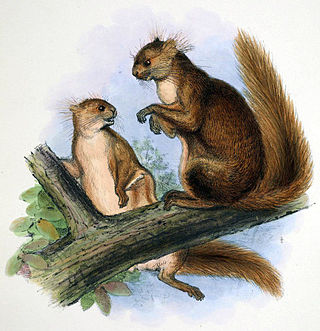
Belomys is a genus of squirrels that contains a single extant species, the hairy-footed flying squirrel (Belomys pearsonii).

The red giant flying squirrel or common giant flying squirrel is a species of rodent in the family Sciuridae (squirrels). It is found in a wide variety of forest–types, plantations and more open habitats with scattered trees in Southeast Asia, ranging north to the Himalayas and southern and central China. One of the largest arboreal squirrels, all populations have at least some reddish-brown above and pale underparts, but otherwise there are significant geographic variations in the colours. The taxonomic position of those in the Sundaic region is generally agreed upon, but there is considerable uncertainty about the others, which variously have been included in this or other species, or recognized as their own species.

The black flying squirrel or large black flying squirrel is a species of rodent in the family Sciuridae. It is found in Brunei, Indonesia, and Malaysia; its habitat is primary and secondary forests and gardens where it uses tree hollows. It feeds on fruits, nuts and other vegetable matter. It is likely not threatened and is adaptable to habitat loss. Black flying squirrels tend to have smaller populations than other squirrels because female black flying squirrels breed infrequently and have a small litter size of just one young.
The Kashmir flying squirrel is a species of rodent in the family Sciuridae. It is monotypic within the genus Eoglaucomys. It is found in Afghanistan, India and Pakistan. Its natural habitat is subtropical or tropical dry forests. It is threatened by habitat loss. The Afghan flying squirrel is usually considered a subspecies.

The northern palm squirrel, also called the five-striped palm squirrel, is a species of rodent in the family Sciuridae. Some authorities recognize two subspecies, F. p. pennantii and F. p. argentescens. It is a semi-arboreal species found in tropical and subtropical dry deciduous forests and many other rural and urban habitats. It is a common species with a wide range and the International Union for Conservation of Nature has rated its conservation status as being of "least concern".

The jungle palm squirrel, jungle striped squirrel, or Western Ghats squirrel is a species of rodent in the family Sciuridae which is endemic to India.

The red and white giant flying squirrel is a species of rodent in the family Sciuridae. It is a very large, dark rufous-red, buff and white flying squirrel found in forests at altitudes of 800–3,500 m (2,600–11,500 ft) in mainland China and 1,200–3,750 m (3,940–12,300 ft) in Taiwan, although the population of the latter island is distinctive and likely better regarded as a separate species, the Taiwan giant flying squirrel. Additionally, the red and white giant flying squirrel possibly ranges into northeastern South Asia and far northern Mainland Southeast Asia. This squirrel has a wide range and is relatively common, and the International Union for Conservation of Nature lists it as being of "least concern".

Petaurista is a genus of rodent in the family Sciuridae. They are large to very large flying squirrels found in forests and other wooded habitats in southern and eastern Asia.

The spotted giant flying squirrel, also known as the lesser giant flying squirrel, is a species of rodent in the family Sciuridae. It is found in hill and mountain forests at altitudes of 200–4,000 m (660–13,120 ft) in Southeast Asia north to central China and the east Himalayan region, although the northern populations sometimes are regarded as separate species as the grey-headed giant flying squirrel, Chindwin giant flying squirrel and P. marica. Two of these, as well as a few other populations, lack the white spots on the upperparts for which it is named. Although a large flying squirrel, it is a relatively small giant flying squirrel.
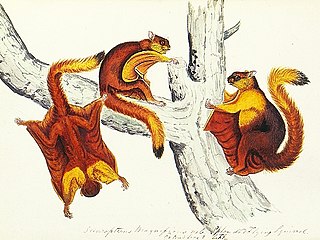
Hodgson's giant flying squirrel is a species of rodent in the family Sciuridae. This large flying squirrel lives in Himalayan forests in Asia. Like other flying squirrels, it is nocturnal and able to glide long distances between trees by spreading out its patagium, skin between its limbs.

The Bhutan giant flying squirrel, also known as the Gray's giant flying squirrel or noble giant flying squirrel, is a species of rodent in the family Sciuridae. This species lives in Himalayan forests and it is one of the largest flying squirrels. Like other flying squirrels, it is mainly nocturnal and able to glide long distances between trees by spreading out its patagium, skin between its limbs.
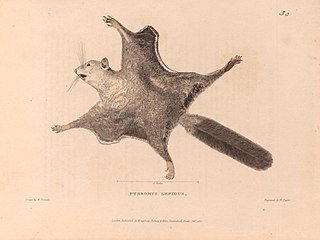
The arrow flying squirrel is a species of flying squirrel. It is endemic to Java and Bangka, Indonesia. The population is unknown as it has only been collected from a few localities. It is nocturnal and arboreal and may be found in primary and secondary forest. It is threatened by forest loss due to logging and agriculture and there are no known conservation actions.

The Japanese dwarf flying squirrel is one of two species of Old World flying squirrels in the genus Pteromys. During the day this squirrel hides in a hole, usually in a coniferous tree, emerging at night to feed.
The Mechuka giant flying squirrel is a species of rodent in the family Sciuridae. First described in 2007 from East Himalayan forests at altitudes of 1,500–2,500 m (4,900–8,200 ft) in the region of Mechuka of north-central Arunachal Pradesh in India, its taxonomic status and position is not fully resolved. it was originally described as P. nigra but has been replaced by mechukaensis because it was a primary homonym of P. nigra Wang 1981.
The Mishmi giant flying squirrel is a species of rodent in the family Sciuridae. First described in 2009 from East Himalayan forests at altitudes of 600–1,600 m (2,000–5,200 ft) in the Mishmi Hills of northeastern Arunachal Pradesh in India, the taxonomic status and position of this giant flying squirrel is not fully resolved.
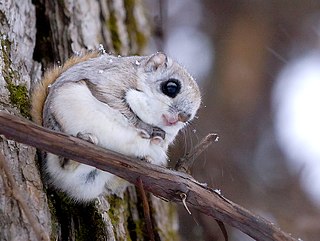
The Ezo flying squirrel or Ezo-momonga is a subspecies of the Siberian flying squirrel. It is endemic to Hokkaidō, Japan, part of the region once known as Ezo. In the legends of the local Ainu, the Ezo flying squirrel or A-kamui is a tutelary deity of children. Together with the Ezo chipmunk and Ezo squirrel, it is one of the three sciurids found on the island, to the north of Blakiston's Line, each having its own particular ecological niche.

